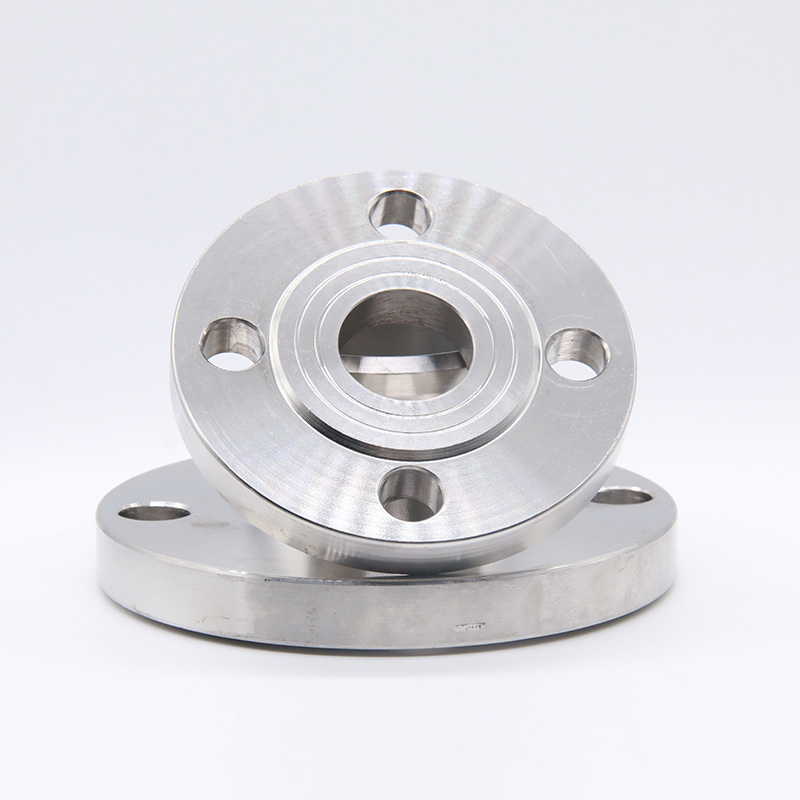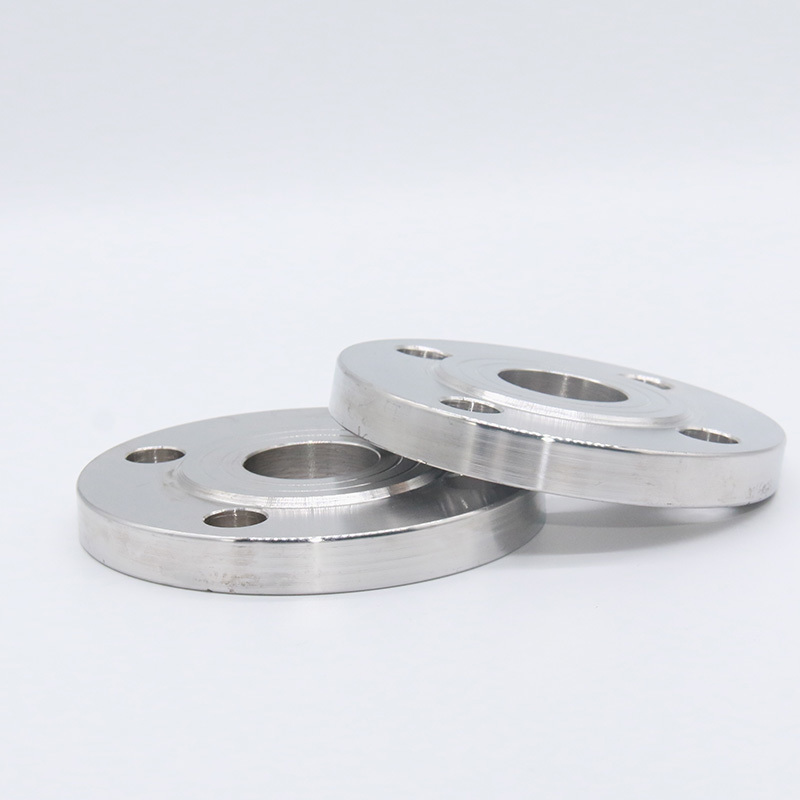PL Flange
Key Word:
Category:
Products Detial
| Standard | ANSI | ANSI B16.5, ASME B16.47 series A/B |
| DIN | Germany 6bar, 10bar, 16bar, 25bar, 40bar | |
| GOST | GOST 12820/12821/12836 | |
| EN1092-1 | EN1092-01/05/11/12/13 | |
| JIS | JIS B 2220-1984, KS B1503, JIS B 2216 | |
| BS4504 | BS4504 BS10 Table D/E | |
| Material | ANSI | CS A105, S235, Steel 20; SS 304/304L, 316/316L |
| DIN | CS RST37.2, S235JRG, P245GH, P250GH; SS 304/304L, 316/316L | |
| GOST | CS Steel 20, 16MN, Q235 | |
| EN1092-1 | CS RST37.2, S235JRG, C22.8 | |
| JIS | SS400, SS 304/304L, 316/316L | |
| BS4504 | CS RST37.2, S235JRG, C22.8; SS 304/304L, 316/316L | |
| Pressure | ANSI | Class 150, 300, 600, 900, 1500, 2500lbs |
| DIN | PN6, PN10, PN16, PN25, PN40 | |
| GOST | PN6, PN10, PN16, PN25, PN40, PN63, PN100 | |
| EN1092-1 | PN6, PN10, PN16, PN25, PN40, PN63, PN100 | |
| JIS | 5K, 10K, 16K, 20K, 30K, 40K | |
| BS4504 | PN6, PN10, PN16, PN25, PN40 | |
| Size | ANSI | 1/2" - 80" |
| DIN | DN15-DN2000 | |
| GOST | DN15-DN1600 | |
| EN1092-1 | DN15-DN2000 | |
| JIS | 15A-1500A | |
| BS4504 | DN15-DN2000 | |
| Certification: | SGS,ISO,BV,TUV,CEM ... | |
| Length: | 3/8" ~80" | |
| Technique: | Forged | |
| Process: | Drilling/Bending/Stamping | |
| Pressure: | PN2.5bar~PN100bar、CLASS150~CLASS1500,PN0.6-PN400、5K-40K,API 2000-15000 | |
| Connection: | Welding, Threaded | |
| Wall thickness: | SCH5S, SCH10S, SCH10, SCH40S,STD, XS, XXS, SCH20,SCH30,SCH40, SCH60,SCH80, SCH160, XXS and etc. | |
| Type: | Plate,threaded,lip-on,socket welding,lap joint,blind,welding neckweld neck flange, slip on flange, blind flange, tube sheet, threaded flange, | |
| socket weld flange, plate flange, spectacle blind, LWN, Orifice flange, anchor flange.(En1092-1 PN10 Pn16 DN900 DN750 Plate Steel Stainless Steel Flange) | ||
| Material: | Stainless steel: A182F304/304L, A182 F316/316L, A182F321, A182F310S, A182F347H,A182F316Ti, A403 WP317, 904L, 1.4301,1.4307,1.4401,1.4571,1.4541, 254Mo and etc. | |
| Duplex stainless steel: UNS31803, SAF2205, UNS32205, UNS31500, UNS32750 , UNS32760,1.4462,1.4410,1.4501 and etc. | ||
| Nickel alloy: inconel600, inconel625, inconel690, incoloy800, incoloy 825, incoloy 800H,C22, C-276, Monel400, Alloy20 etc.Cr-Mo alloy: A182F11, A182F5, A182F22, A182F91, A182F9, 16mo3 etc. | ||
Product description
Plate flat welded flange, neck butt welded flange, neck flat welded flange, socket welded flange, butt welded ring loose flange, flange cover.
Introduction of Flange:
Flange, also called flange flange disk or flange. The flange is a part connected between the pipe and the pipe, used for the connection between the pipe end; Also useful in equipment inlet and outlet flange, used for connection between two equipment, such as reducer flange. Flange connection or flange joint, refers to the flange, gasket and bolt three mutually connected as a group of sealing structure detachable connection. Pipe flanges refer to the flanges used in pipe fittings and the import and export flanges used in equipment. There are holes in the flange, and the bolts make the two flanges tightly connected. The flanges are gasketed. Flange consists of threaded connection (thread connection) flange, welded flange and clamp flange. Flanges are used in pairs, wire flanges can be used for low pressure pipes, and welded flanges for more than 4 kg of pressure. Put a gasket between the two flanges and fasten them with bolts. Flanges of different pressures have different thicknesses, and they use different bolts. Water pumps and valves, when connected with pipes, the local parts of these equipment are also made into the corresponding flange shape, also known as flange connection. All in the two plane around the use of bolt connection at the same time closed connection parts, generally called "flange", such as the connection of ventilation pipe, this kind of parts can be called "flange class parts". But this connection is only a part of the equipment, such as the connection of the flange and the water pump, it is not good to call the water pump "flange parts". Relatively small, such as valves, can be called "flange parts". The reducer flange is used for the connection between the motor and the reducer, and the connection between the reducer and other equipment.
Flange classification method:
1. According to HG industry standard: integral flange (IF), threaded flange (Th), plate flat welded flange (PL), butt welded flange with neck (WN), butt welded flange with neck flat welded flange (SO), socket welded flange (SW), butt welded ring loose flange (PJ/SE), flat welded ring loose flange (PJ/RJ), lining flange cover (BL(S)), flange cover (BL).
2: According to the petrochemical (SH) industry standard: threaded flange (PT), butt welding flange (WN), flat welding flange (SO), socket welding flange (SW), loose sleeve flange (LJ), flange cover (not note).
3: According to the mechanical (JB) industry standard: integral flange, butt welding flange, plate flat welding flange, butt welding ring plate loose sleeve flange, flat welding ring plate loose sleeve flange, flanging ring plate loose sleeve flange, flange cover.
4: According to the national (GB) standard: integral flange, threaded flange, butt welded flange, flat welded flange with neck, welded flange with neck socket, butt welded ring with neck loose sleeve flange, flat welded flange, butt welded ring with loose sleeve flange, flat welded ring with loose sleeve flange, flanging ring with loose sleeve flange, flange cover.
Material classification of flange:
Carbon steel (WCB), LCB (low temperature carbon steel), LC3 (3.5% nickel steel), WC5 (1.25% 0.5% chrome molybdenum steel), WC9 chromium (2.25%), C5 (0.5% 5% chromium molybdenum), C12 (9% 1% chromium molybdenum), CA6NM (4 (12% chromium steel), CA15 (4) (12% chromium), CF8M (3 16 stainless steel), CF8C(347 stainless steel), CF8(304 stainless steel), CF3(304L stainless steel), CF3M(316L stainless steel), CN7M(alloy steel), M35-1(Monel), N7M(Haster nickel alloy B), CW6M(Haster nickel alloy C), CY40(Inco nickel alloy), etc.
Connection mode of flange:
Flange connection is the two pipes, pipe fittings or equipment, respectively fixed on a flange plate, between the two flanges, plus flange pad, bolted together to complete the connection. Some pipe fittings and equipment have their own flange, also belong to the flange connection. Flange connection is an important connection mode in pipeline construction. Flange connection is easy to use and can withstand greater pressure. Flange connection is widely used in industrial pipeline. In the home, the pipe diameter is small, and is low pressure, not visible flange connection. If you're in a boiler room or a production site, there are flanged pipes and equipment everywhere. According to the connection method, the connection types of flange can be divided into: plate flat welded flange, neck flat welded flange, neck butt welded flange, socket welded flange, thread flange, flange cover, neck butt welded ring loose sleeve flange, flat welded ring loose sleeve flange, ring groove flange and flange cover, large diameter flat flange, large diameter high neck flange, Line blind plate, butt welded ring loose sleeve flange, etc.
Flange production process:
The production process is mainly divided into forging, casting, cutting, rolling these four kinds.
Cast and forged flanges
Casting out of the flange, blank shape size is accurate, processing amount is small, low cost, but there are casting defects (pores. Crack. Inclusion); The internal structure of the casting is less streamlined (if it is a cutting part, the streamline is worse);
The forged flange is generally less carbon than the casting flange is not easy to rust, the forging is streamlined, the organization is dense, the mechanical properties are better than the casting flange;
Improper forging process will also appear large or uneven grain, hardening crack phenomenon, forging cost is higher than casting flange.
Forgings can withstand higher shear and tensile forces than castings.
The advantage of casting is that it can produce a more complex shape and the cost is relatively low;
The advantage of forging is that the internal organization is uniform, there is no porosity in the casting, inclusion and other harmful defects;
The difference between casting flange and forging flange from the production process, such as centrifugal flange is a kind of casting flange.
Centrifugal flange belongs to the production flange of precision casting method. This kind of casting is much finer than ordinary sand casting, and its quality is improved a lot. It is not easy to have problems such as loose organization, porosity, trachoma and so on.
First of all, we need to understand how centrifugal flanges are produced, and the process method and products of centrifugal casting to make flat welding flanges are characterized by the product being processed through the following process steps:
(1) Put the selected raw material steel into the medium frequency electric furnace for smelting, so that the temperature of molten steel reaches 1600-1700℃;
② Preheat the metal mold to 800-900℃ to keep a constant temperature;
③ Start the centrifuge and inject the molten steel in step ① into the preheated metal mold in step ②;
④ The casting is naturally cooled to 800-900℃ for 1-10 minutes;
⑤ Cool the casting with water to close to normal temperature, and remove the mold.
Let's understand the production process of forging flange:
The forging process generally consists of the following procedures, namely, selecting high-quality billets for blanking, heating, forming, and cooling after forging. The forging process includes free forging, die forging and membrane forging. Production, according to the size of the quality of the forging, the number of production batch choose different forging methods.
Free forging has low productivity, large processing allowance, but simple tools and large versatility, so it is widely used in forging simple shape of single piece, small batch production of forgings. Free forging equipment includes air hammer, steam - air hammer and hydraulic press, which are suitable for small, medium and large forging production respectively. Die forging has high productivity, simple operation, easy to realize mechanization and automation. The die forging parts have high dimensional precision, small machining allowance, and more reasonable distribution of fiber structure, which can further improve the service life of parts.
Die forging is called model forging. The heated blank is placed in the forging die fixed on the die forging equipment.
Generally speaking, the quality of forged flange is better. It is generally produced by die forging. The crystal structure is fine, the strength is high, and of course the price is more expensive.
Whether casting flange or forging flange belong to the common manufacturing method of flange, depending on the strength requirements of the parts that need to be used, if the requirements are not high, you can also choose turning flange.
Three, cutting flange
The disc with the inner and outer diameter and thickness of the flange is directly cut out on the middle plate, and then the bolt hole and water line are processed. The flange produced in this way is called cut flange, the maximum diameter of this kind of flange to the width of the plate.
Four, winding flange
The process of cutting a strip from a medium plate and then winding it into a round is called winding, which is used in the production of some large flanges. After successful winding, welding is performed, then flattening is performed, and the waterline and bolt holes are processed.
Application scope of flange:
Because the flange has good comprehensive performance, so it is widely used in chemical industry, construction, water supply, drainage, petroleum, light and heavy industry, freezing, health, water heating, fire, power, aerospace, shipbuilding and other basic engineering.
Company Show

Related Products
Product Inruiry
Please fill in the form to get more information as soon as possible








